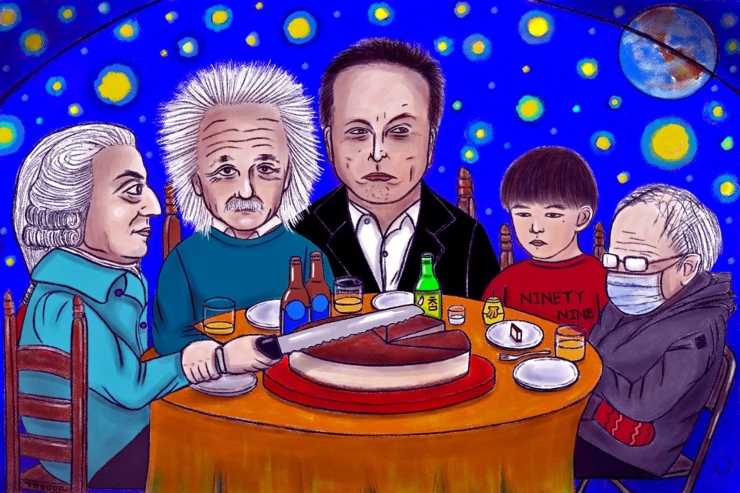What is the fair way of distributing limited resources? Currently, no division method can properly handle this critical “cake-cutting” problem because it is impossible, in practical terms, to distribute limited resources naturally and fairly while satisfying everyone. Inspired by how nature distributes the particles of a physical system in thermodynamic equilibrium, Ji-Won Park, Jaeup U Kim, Cheol-Min Ghim, and Chae Un Kim propose the Boltzmann division as a new and fair method.
One day, humans may migrate to extraterrestrial planets (Figure 1)—let’s imagine, on Mars. If four adults and a six-year-old child share their only food, a cake (a limited resource), how should they cut the cake fairly? Is 1/n really fair? Egalitarianism makes humans lethargic. However, other methods of distributive justice, such as capitalism and socialism, are inflexible. Under capitalism, people who have contributed nothing to making the cake will always go hungry. Under socialism, those who have greatly contributed to making the cake will always be unsatisfied. In addition, liberalism is laissez-faire and too arbitrary. It is time to rethink our fair share for a better society.
Figure 1. Cake-cutting problem on Mars

Fair division is a significant, long-standing problem closely linked to social and economic justice. The fair-division problem, or the cake-cutting problem as it’s known more generally, has received considerable attention in a broad range of research fields, including economics, political science, mathematics, and computer science. A variety of division methods—such as cut-and-choose—have been proposed, but they hardly address real-world problems given their prohibitive computational complexity and unrealistic assumptions about human behaviour. The most critical issue of fair division is how to divide social goods when participating players represent different human factors (such as contributions, needs, and preferences) with respect to the goods and exhibit selfish and greedy behaviours. Currently, no existing division method can properly handle this critical problem because it is impossible, in practical terms, to distribute limited resources naturally and fairly while satisfying everyone.
Inspired by how nature distributes the particles of a physical system in thermodynamic equilibrium, in our 2022 article entitled “The Boltzmann Fair Division for Distributive Justice,” we proposed the Boltzmann division as a new and fair cake-cutting method. The Boltzmann distribution in physical science describes the probability that a particle will be in a certain energy state at a given system temperature, and it provides the most probable, natural, and unbiased distribution at thermal equilibrium. The distribution can vary widely—from uniform to extremely skewed—depending on the system’s temperature.
When we apply the Boltzmann distribution to the cake-cutting problem, a cake’s slices (corresponding to the particles in physical science) are distributed based on the participating players’ contributions to making the cake. The distribution can employ a goods-centric process instead of a player-centric one, eliminating the need of considering players’ selfish and greedy behaviour. How widely cake slices are spread over in the Boltzmann division depends on the “division constant” (β) of the cake-cutting, which can be determined by referees of the cake-cutting. When the division constant becomes 0, the slices can be distributed evenly, thus converging to the egalitarian solution. The higher the division constant, the more cake can be distributed to those who contributed most to making it. This seemingly arbitrary constant, however, can be fixed by enforcing its optimal value for, say, the greatest happiness for the greatest number.
The Boltzmann fair division for distributive justice has two properties:
- In distributing limited resources, it considers the human factors of participants (e.g., contribution, need, and preference) and inherently maximizes the distribution entropy.
- Its optimality comes from the maximization of the total utility (happiness or satisfaction) of all participating players in the division process.
The fair division we seek is the cake distribution that is optimised to ensure the largest sum of the utilities of the participating players. Under an existing social welfare function such as utilitarianism, the total utility of all participating players is maximised when all receive equal slices of cake. This solution may have been universally persuasive and reasonable in the past, but the new social welfare function we introduce shows that there is a better division than uniform (egalitarian) cake division. We propose distributing the cake to reflect players’ contributions to making the cake, but without allowing someone who made a large contribution to monopolise the cake alone. This is because all players have different utility functions, and their needs—not their contributions—are converted into their utility. Thus, we show that the Boltzmann fair division is superior to other methods, including uniform (egalitarian) cake division. One of the biggest advantages of the Boltzmann division is that even those who have made no contribution but have need of the cake (i.e., the socially disadvantaged) can have a slice. Thus, the Boltzmann division provides the most probable and unbiased division regardless of any a priori dogma or ethical norms while integrating realistic human factors.
Compared with existing conventional models, the Boltzmann division is simple and easily expandable to multiple players. It is also a well-balanced method with several superior aspects compared with conventional methods, such as envy-freeness or proportionality. It is especially favourable to the socially disadvantaged or underprivileged; therefore, it could serve as a guideline for reducing inequality in controversial social and economic problems. In addition, the Boltzmann division is highly versatile and can be fine-tuned to directly apply to various social, economic, and political division problems.
The Boltzmann fair division has great potential to become a primary research subject for future fair-division studies. It may eventually make a unique contribution to resolving controversial and complex real-world division problems such as income/wealth redistribution or international negotiations on fighting climate change.
♣♣♣
Notes:
- This blog post is based on The Boltzmann fair division for distributive justice, Scientific Reports. The research was conducted with the support of the Samsung Science and Technology Foundation.
- The post represents the views of its author(s), not the position of LSE Business Review or the London School of Economics.
- Featured image NOT under Creative Commons. Copyright 2023 Ji-Won Park. All right reserved
- When you leave a comment, you’re agreeing to our Comment Policy.





